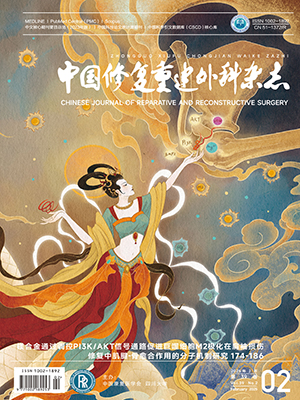| 1. |
Moon MS. Development in the management of tuberculosis of the spine. Curr Orthop, 2006, 20(2):132-140.
|
| 2. |
Rajasekaran S, Soundarapandian S. Progression of kyphosis in tuberculosis of the spine treated by anterior arthrodesis. J Bone Joint Surg (Am), 1989, 71(9):1314-1323.
|
| 3. |
Zhang HQ, Lin MZ, Ge L, et al. Surgical management by one-stage posterior transforaminal lumbar debirdment, interbody fusion, and posterior instrumentation for lumbo-sacral tuberculosis in the aged. Arch Orthop Trauma Surg, 2012, 132(12):1677-1683.
|
| 4. |
Gong K, Wang Z, Luo Z. Single-stage posterior debridement and transforaminal lumbar interbody fusion with autogenous bone grafting and posterior instrumentation in the surgical management of lumbar tuberculosis. Arch Orthop Trauma Surg, 2011, 131(2): 217-223.
|
| 5. |
Lee JS, Moon KP, Kim SJ, et al. Posterior lumbar interbody fusion and posterior instrumentation in the surgical management of lumbar tuberculous spondylitis. J Bone Joint Surg (Br), 2007, 89(2): 210-214.
|
| 6. |
Bridwell KH, Lenke LG, McEnery KW, et al. Anterior fresh frozen structural allografts in the thoracic and lumbar spine. Do the work if combined with posterior fusion and instrumentation in adult patients with kyphosis or anterior column defects? Spine, 1995, 20(12):1410-1418.
|
| 7. |
Chow JH, Chan CC. Validation of the Chinese version of the Oswestry Disability Index. Work, 2005, 25(4):307-314.
|
| 8. |
Jain AK, Dhammi IK, Prashad B, et al. Simultaneous anterior decompression and posterior instrumentation of the tuberculous spine using an anterolateral extrapleural approach. J Bone Joint Surg (Br), 2008, 90(11):1477-1481.
|
| 9. |
Fukuta S, Miyamoto K, Masuda T, et al. Two-stage (posterior and anterior) surgical treatment using posterior spinal instrumentation for pyogenic and tuberculotic spondylitis. Spine (Phila Pa 1976), 2003, 28(15):E302-308.
|
| 10. |
Flamme CH, Hurschler C, Heymann C, et al. Comparative biomechanical testing of anterior and posterior stabilization procedures. Spine (Phila Pa 1976), 2005, 30(13):E352-362.
|
| 11. |
Laheri VJ, Badhe NP, Dewnany GT. Single stage decompression, anterior interbody fusion and posterior instrumentation for tuberculous kyphosis of thedorso-lumbar spine. Spinal Cord, 2001, 39(8):429-436.
|
| 12. |
Li L, Xu J, Ma Y, et al. Surgical strategy and management outcomes for adjacent multisegmental spinal tuberculosis. Spine (Phila Pa 1976), 2014, 39(1):E40-48.
|
| 13. |
Liu P, Sun M, Li S, et al. A retrospective controlled study of three different perative approaches for the treatment of thoracic and lumbar spinaltuberculosis:three years of follow-up. Clin Neurol Neurosurg, 2015, 128:25-34.
|
| 14. |
Wang X, Pang X, Wu P, et al. One-stage anterior debridement, bone grafting and posterior instrumentation vs. single posterior debridement, bone grafting, and instrumentation for the treatment of thoracic and lumbar spinal tuberculosis. Eur Spine J, 2014, 23(4): 830-837.
|
| 15. |
马远征. 关于脊柱结核病灶清除术的入路问题. 中国脊柱脊髓杂志, 2012, 22(9):774.
|
| 16. |
崔旭, 马远征, 陈兴, 等. 脊柱结核前后路不同术式的选择及其疗效. 中国脊柱脊髓杂志, 2011, 21(10):807-811.
|
| 17. |
Zhang H, Huang S, Guo H, et al. A clinical study of internal fixation, debridement and interbody thoracic dusion to treat thoracic tuberculosis via posterior approach only. Int Orthop, 2012, 36(2): 293-298.
|




